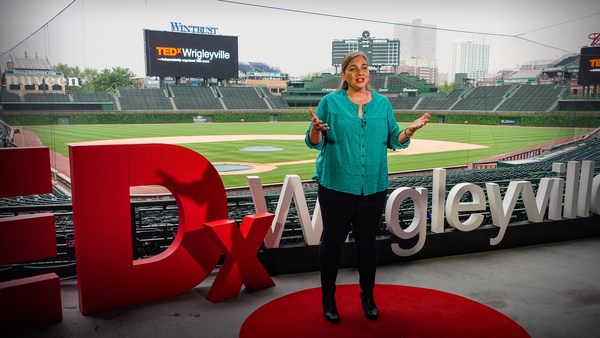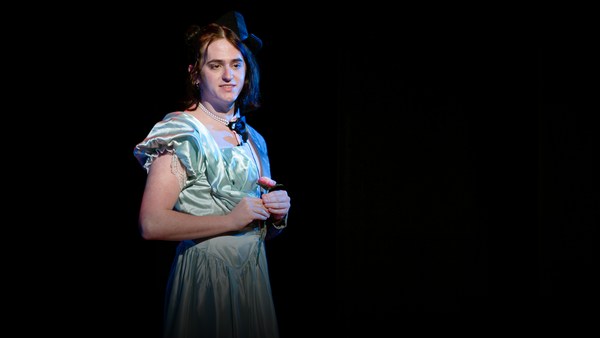Hello, everyone. As he said, my name is Margaret Hall. I'm a musical theater historian, writer and teacher, and I'm here to talk to you about how we talk about art.
Theater is, at its core, a collaborative art form. It's a way for human beings to communicate with one another. Why then do we struggle to communicate about the art form itself?
There is one massive foundation-shifting question that many people working in the American theater avoid, and that question is: How do we approach aging art? The American musical is a relatively young art form.
If we use 1866's "The Black Crook" as our marker, then the art form is only 156 years old. Now that feels like a very old age to us because no human being is going to reach that age naturally. But if you compare the American musical to the forms of theater that reached precedence before it, it is a baby. To us, it feels like the American musical has always been, since no one in this room and none of our parents and most likely any of our grandparents were alive in 1866 to see it begin.
Five generations is approximately the length of time it takes for a tradition to feel ancient to a child. Think about that cure someone in your circle has for the common cold or that recipe your grandmother guards like a precious jewel. Now chances are that cure is more placebo than it is effect, and your grandmother's secret recipe may have come from a cookbook her grandmother owned way back in the day. But by the time it reaches us, it's taken on a different, constant feeling. You're never going to meet the person who originated the tradition, and so it becomes a part of the fabric of your reality, something that you base your knowledge of who you and the people around you are. And in the case of the American theater, you will never meet the artist.
Generations apply to art, just as they do artists. 25 years is the average dividing line between the eras as tastes change and we use art to ask different questions. The American musical is currently in its sixth artistic generation, which means we just passed the ancient marker. That is a milestone in and of itself. Think of it like we've gone from being a teenage art form to a young adult. Now, that transition may seem small on paper, but as anyone who has ever gone back to their high school after their first semester of college can tell you, that gulf is wider than you think.
(Laughter)
We've grown. We're different. We've learned. We're still the same person, of course, but our hearts and minds are open to things we didn't even know existed. The American musical is growing up, and it is time for us to address the growing pains.
For many of us, our instinct is to bury the phases of life that we cringe to look back on. And just like a Hot Topic T-shirt stashed in the back of a closet, we like to pretend it never existed.
(Laughter)
I'm here to tell you that as satisfying as that may feel in the moment, ignoring it is not the answer. You can donate the shirt. You can repurpose it into a cleaning rag. You can even light it on fire and dance around the embers if you so choose. But you cannot make the shirt never have existed. The fact is, many older shows are difficult for us as modern audience members today. And honestly, that is one of my greatest joys because it is a direct sign of progress. Frankly, I would be a little bit worried if sensibilities had not changed in 156 years.
Remember that foundation-shifting question? How do we approach aging art? Well, we haven't been approaching it. The industry at large has been avoiding this question since the nostalgia craze of the 1970s. So great is the avoidance that we don't even really have the language that we need to have these conversations. We have to start thinking of theater as something that is alive rather than a static museum piece. It contains a piece of the creator's soul which lives on in the work. We have to start thinking of theater like a dynamic, aging community member. What does this piece of theater trying to communicate? Is it still communicating that message effectively long after its initial creation? Or does something else communicate that message better now? Is it doing more help than harm? These are the questions that I ask myself every time I dust off a musical from yesteryear.
I'm here to give you my personal framework, which I teach to students across the globe. Now it is not perfect, and I'm going to spend the rest of my life refining it. But it is a start; it is a start in looking at the American musical as a progression and in finding language to talk about how things do and do not age in the modern zeitgeist.
The five categories are as follows. Category one: "Active." The piece, while not perfect, communicates its message effectively without any potential problems getting in the way of that communication.
Category two: "Tricky." The problems within the piece can be mitigated by how the piece is directed or performed.
Category three: "Troublesome." The problems are baked into the piece itself, but if they are addressed in a cognizant manner, the show still has something salient to say.
Category four: "Augmented." You need to completely redo an aspect of the piece in order to make it palatable. This is where the concept of a revisal comes in.
Category four: "Archived." The piece has value historically, but it does not need to be publicly performed anymore. It has more value as a piece of where we have been than where we are going.
Now, the divisions between these five categories are porous. A show may be tricky to one person and troublesome to another. We all approach art from different vantage points and therefore have different opinions.
However, for the sake of giving you an example of the framework, I would like to take the canon of one of the American musical's greatest and most influential ancestors and present it to you within the framework. Oscar Hammerstein II.
Now first up is the "Active" category. Now Oscar died in 1960, which means that two artistic generations have passed since he passed. He's essentially the great grandfather to our current artistic generation. But many of his insights remain as cuttingly clear as they were when he first presented them. Consider "The Sound of Music." Its message of heart, hope and humanity resonates with audience members across the world, making it one of the most performed regional, community and educational theater pieces in the entire country. It still has a tale to tell, and audiences are still learning its lessons.
Next up is the "Tricky" category, which in my opinion is the most flexible part of the framework. It's up to us as artists to take these pieces and elevate them in a responsible manner for a modern retelling. Take "Oklahoma!" and "South Pacific." Both of these shows had landmark revivals in the last 15 years that upended the way the current generation views them, without changing a single word that Oscar Hammerstein II wrote. This is the material that has the strength for a modern retelling, provided we lift it off the page in a responsible manner.
The third category is "Troublesome." Now “Troublesome” are shows that still resonate with modern audiences. but we may squirm a little bit in our seat if we look too close. "The King and I" is a perfect example of a show with many worthwhile messages: the importance of being a lifelong learner, seeing your fellow man as your equal, working together toward a common goal, while also having aspects that would not be well received if it was first presented today. The white saviorism embedded in the initial source text, the treatment of East Asia, the way the Siamese women are underwritten and so on.
Category four, "Augmented," is when a show's troubles begin to outweigh its triumphs. Consider "Flower Drum Song." "Flower Drum Song" was written from a place of deep, abiding love and respect for the Asian American community. But at the end of the day, Oscar was writing from the perspective of a community that he could never truly be a part of. In 2002, David Henry Hwang, an Asian American playwright, was brought in to dramatically revise the piece, using songs that have become a part of the American zeitgeist as the soundtrack for far more honest representation.
The final category, "Archived," is perhaps the most controversial. Some people confuse this category with bad and they are not at all synonymous. Just because a show is archived does not mean it was never useful. In fact, typically they were extremely useful in their day. Consider 1927's "Show Boat." "Show Boat" is inarguably one of the most important musicals in the history of the American theatrical canon. It changed the kind of conversations we could have onstage and revolutionized what a musical could look like. It also has ceased to create productive discussion with modern audiences. Now the book has been rewritten ad nauseum as we continue to pull "Show Boat" into the modern era. But in my opinion, it now holds more value as an example of where we have been than an example of where we are going.
Now you may disagree with me on any of these placements. These six shows could exist in any number of categorical permutations. What's important is that we have these discussions and we have the language to communicate in those discussions.
We have to have these conversations because they are the only way that we will grow. We have to make conscious decisions about what art does and does not serve us as a community and what does and does not serve us going forward.
Thank you for listening to me today. I hope that we all have these difficult conversations with grace and consideration.
(Applause)





